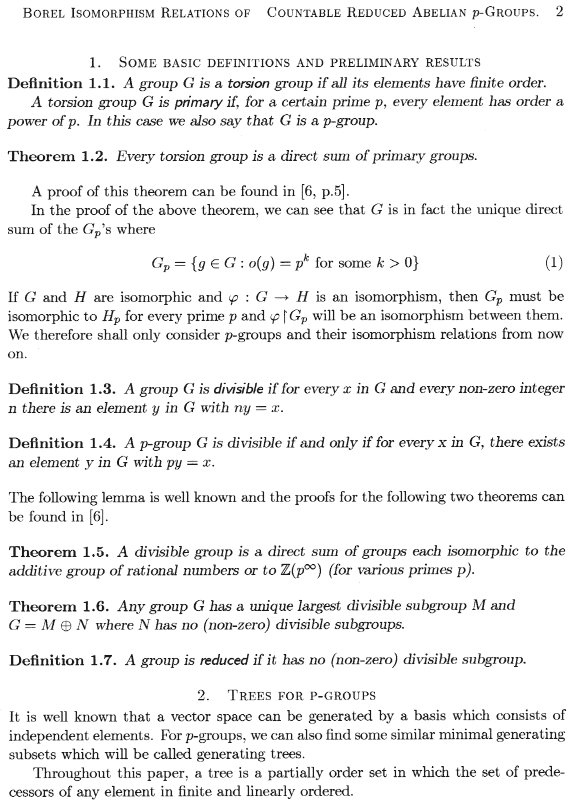Borel Isomorphism Relations of
Countable Reduced Abelian p-groups
Abstract
This paper covers two major results. The first one states that any algorithm that can determine whether two arbitrarily given countable reduced 2-groups are isomorphic is as complicated as the process of computing their Ulm invariants, namely, it has to go through a transfinite iteration of unbounded countable length. In the language of descriptive set theory, this can be stated precisely as "the set {(G1, G2): G1, G2 are isomorphic reduced 2-groups} is relatively D11 to the set { (G1, G2): G1, G2 are reduced 2-groups} but is not relatively Borel".
The second theorem denies the possibility of finding a Borel process to construct isomorphisms between any two given isomorphic countable reduced 2-groups.
Introduction
H. Ulm proved in 1933 that the structure of a reduced countable Abelian p-group is completely determined up to isomorphism by a sequence of invariants called the Ulm invariants. The original methods he invented for the computation of these invariants and the construction of isomorphisms require a transfinite iteration whose length, depending on the group, can be any arbitrarily large countable ordinal. One may therefore ask whether there is an alternative algorithm that requires only transfinite recursions with bounded countable lengths. More precisely, if each countable p-group is coded by an element in the Cantor space, can we find a Borel partial function from the Cantor space into itself that would compute the rank and Ulm invariants of any reduced countable Abelian p-group? Can we find a Borel procedure that can construct an isomorphism between any two given isomorphic reduced countable Abelian p-groups? In this paper, we prove that the answers to both questions are unfortunately negative.
We start our investigation with the search for a minimal substructure of a p-group that generates the whole group and also retains the characteristics of the group. Unless otherwise stated, all groups in this paper are assumed to be Abelian and the group operation is addition.
To download the whole paper (27 pages), click the following button. However, you must have the Adobe Acrobat Reader installed in your browser, otherwise you can install it by clicking here.
[paper 1]



8800 Grossmont College Drive
El Cajon, California 92020
619-644-7000
Accessibility
Social Media Accounts